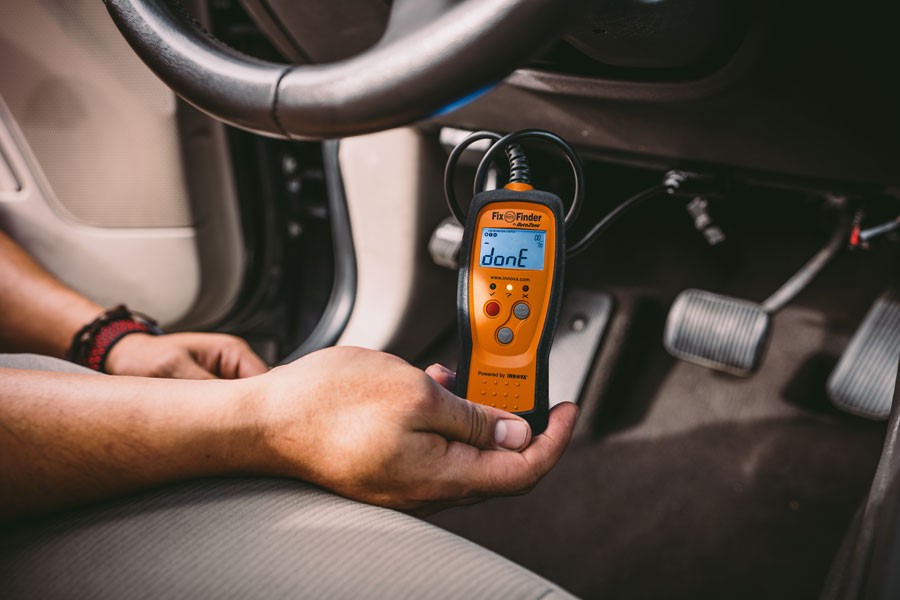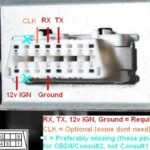Modern vehicles are complex machines, but diagnosing their issues doesn’t have to be a mystery. Thanks to advancements in automotive technology, tools like the OBD2 reader have become invaluable for car owners and enthusiasts alike. An OBD2 reader, or scanner, is a user-friendly device that plugs into your car’s onboard diagnostic system, allowing you to quickly check and understand those perplexing “check engine” lights and other potential problems. Learning how to use an OBD2 reader to check codes is a straightforward process that can save you time, money, and unnecessary trips to the mechanic. This guide will walk you through each step, empowering you to take control of your car’s diagnostics from the comfort of your garage.
Connecting Your OBD2 Reader: Getting Started
Before you can decipher any codes, you need to properly connect your OBD2 reader to your vehicle. Thankfully, this is a simple process designed for ease of use. The OBD2 port is a standardized feature in virtually all passenger vehicles manufactured since 1996.
Locating the OBD2 Port:
The most common location for the OBD2 port is underneath the driver’s side dashboard. Look for a 16-pin, trapezoid-shaped female connector. It’s usually easily accessible and visible, but in some models, it might be tucked slightly further in or located within the center console or even under the passenger side dashboard. If you’re unsure, consult your vehicle’s owner’s manual for the precise location.
Connecting the Scanner:
Once you’ve located the OBD2 port, follow these steps for a successful connection:
- Turn Off the Ignition: Ensure your vehicle’s ignition is completely turned off before you begin. This is a safety precaution and ensures proper communication between the scanner and your car’s computer.
- Plug in the OBD2 Reader: Take your OBD2 scanner and align the male connector with the OBD2 port. The trapezoidal shape ensures it only fits in one orientation. Gently but firmly push the scanner’s connector into the port. You might feel a slight resistance and a small wiggle can help ensure a secure connection.
- Turn the Ignition to the “ON” Position (Engine Off): Turn your key in the ignition to the “ON” position. This activates your car’s electrical systems and powers up the OBD2 port, but do not start the engine yet.
- Power Up the Scanner: In most cases, the OBD2 port will provide power to your scanner automatically. You should see the scanner’s screen light up and begin its boot sequence. Some scanners may have a power button you need to press.
- Wait for Initialization: Allow the OBD2 scanner to complete its initialization process. This may involve displaying a welcome screen or prompting you to input vehicle information.
Once connected, your OBD2 reader will typically guide you through any additional setup, such as selecting your vehicle’s make and model, or entering the Vehicle Identification Number (VIN). Some advanced scanners might offer Bluetooth or Wi-Fi connectivity for use with smartphones or tablets, providing a more interactive interface.
Navigating the OBD2 Scanner Menu: Understanding Your Options
After successful connection and boot-up, your OBD2 scanner will present you with a menu of options. The exact menu layout and features will vary depending on the type of scanner you are using – from basic code readers to more advanced professional-grade tools. However, most scanners will include some or all of the following core functions:
- Read Codes: This is the primary function for checking car trouble codes. Selecting “Read Codes” will instruct the scanner to communicate with your vehicle’s computer and retrieve any stored Diagnostic Trouble Codes (DTCs). These codes are alphanumeric identifiers that pinpoint specific areas of malfunction within your car’s systems. The scanner may display the DTC number (e.g., P0301) and sometimes a brief description of the issue. If multiple codes are present, the scanner will usually scroll through them.
- Erase Codes: This option allows you to clear stored DTCs from your vehicle’s computer memory. After you’ve addressed the underlying issue that triggered a code, you can use “Erase Codes” to reset the system and turn off the “check engine” light. Most scanners will prompt you for confirmation before erasing codes to prevent accidental deletion. Important Note: Erasing codes without fixing the problem is not recommended, as the issue will likely return, and you might lose valuable diagnostic information.
- Live Data (Data Stream): Advanced OBD2 scanners offer a “Live Data” or “Data Stream” feature. This powerful function allows you to monitor real-time sensor readings from various parts of your vehicle’s engine and other systems. You can observe parameters like engine temperature, RPM, oxygen sensor readings, and more, helping you diagnose intermittent issues or monitor system performance.
- Freeze Frame Data: “Freeze Frame” captures a snapshot of sensor data at the exact moment a DTC was triggered. This information provides valuable context by showing the conditions (e.g., engine speed, load, temperature) that were present when the fault occurred. This can be extremely helpful in diagnosing intermittent problems or understanding the conditions under which a specific code sets.
- Vehicle Information (Vehicle Info): This section typically displays general information about your vehicle, such as the VIN, calibration IDs, and other build-related data retrieved from the car’s computer.
- I/M Readiness (Inspection/Maintenance Readiness): “I/M Readiness” checks the status of your vehicle’s emissions systems to determine if they are ready for an emissions or smog test. It shows whether various emissions-related monitors have completed their self-tests. If any monitors are incomplete or show a fault, it could indicate a problem that might cause your vehicle to fail an emissions test.
Navigating the scanner menu is usually done using directional buttons and selection buttons on the device. Even Bluetooth or Wi-Fi scanners controlled via smartphone apps will have intuitive interfaces for menu navigation and option selection.
Decoding OBD2 Codes: Understanding the Language of Your Car
Once you select “Read Codes,” your OBD2 scanner will display any stored DTCs. These codes might be accompanied by a short text description, but often, you’ll need to understand the code structure to fully interpret the issue. OBD2 codes follow a standardized format: a letter followed by four numerical digits (e.g., P0301).
Understanding the Code Structure:
-
First Character (Letter): This letter indicates the primary vehicle system where the fault is located:
- P (Powertrain): Relates to the engine, transmission, fuel system, and emissions control systems. This is the most common category of codes.
- B (Body): Indicates issues with body control systems, such as airbags, power windows, interior electronics, and comfort/convenience features.
- C (Chassis): Points to problems with chassis systems like the anti-lock braking system (ABS), traction control, suspension, and steering.
- U (Network/Communication): Signifies communication issues within the vehicle’s computer network (CAN bus) or between different modules.
-
Second Character (Digit): This digit is always either a “0” or a “1”:
- 0: Indicates a generic or standardized code. These codes are the same across all vehicle manufacturers and are defined by OBD2 standards.
- 1: Represents a manufacturer-specific or enhanced code. These codes are defined by the specific car manufacturer and may provide more detailed information than generic codes.
-
Third Character (Digit): This digit specifies the sub-system within the broader system indicated by the first letter:
- 1: Fuel and Air Metering
- 2: Fuel and Air Metering (Injector Circuit)
- 3: Ignition System or Misfire
- 4: Auxiliary Emission Controls
- 5: Vehicle Speed Control and Idle Control System
- 7, 8, 9: Transmission related codes
- A, B, C: Hybrid Propulsion System
-
Fourth and Fifth Characters (Digits): These final two digits are the most specific and pinpoint the exact component or circuit that is experiencing the fault. There are hundreds of possible combinations, each with a specific meaning.
Example Code: P0301
Let’s break down the example code P0301:
- P: Powertrain (engine or transmission related)
- 0: Generic code (standard across manufacturers)
- 3: Ignition System or Misfire
- 01: Specifically points to Cylinder 1.
Therefore, P0301 translates to “Cylinder 1 Misfire Detected.”
While your OBD2 scanner might provide a brief description, for more detailed information about a specific code, you can consult online OBD2 code databases, repair manuals, or reputable automotive websites. Remember, an OBD2 code provides a starting point for diagnosis, not necessarily the definitive answer. Further investigation and testing may be needed to pinpoint the root cause of the problem.
Saving Money and Time with an OBD2 Reader
Investing in an OBD2 reader is not just about understanding your car’s problems; it’s also about saving money and time on car repairs. Here’s how:
- Early Problem Detection: An OBD2 scanner allows you to identify potential issues early on, often before they escalate into more serious and costly repairs. By checking codes regularly, you can catch minor problems and address them proactively.
- Informed Diagnosis: When your “check engine” light illuminates, a scan with an OBD2 reader provides you with valuable diagnostic information before you even visit a mechanic. You’ll be armed with the DTC(s) and a better understanding of the potential issue, enabling more informed conversations with repair shops and preventing unnecessary or inflated repair bills.
- DIY Repairs: For many common car problems, the OBD2 scanner can pinpoint the faulty component, allowing you to perform the repair yourself if you are comfortable with DIY car maintenance. For example, a code indicating a faulty oxygen sensor might be resolved by simply replacing the sensor yourself, saving on labor costs at a repair shop.
- Smog Check Readiness: Before taking your vehicle for a smog or emissions test, you can use the I/M Readiness function on your OBD2 scanner to ensure your car is likely to pass. This can prevent failed tests and the associated re-test fees.
By empowering you to understand your car’s diagnostic codes, an OBD2 reader becomes a valuable tool in responsible car ownership and can contribute to significant savings over the lifespan of your vehicle.
FAQ About Using OBD2 Scanners
How do you use OBD II scanner?
Plug the OBD2 scanner connector into the diagnostic port under your dashboard, turn your vehicle’s ignition to the “ON” position (engine off), and then follow the on-screen instructions provided by your scanner to read and interpret diagnostic trouble codes.
Does car have to be running to use OBD2 scanner?
No, in most cases, you do not need to have the car engine running to use an OBD2 scanner for reading trouble codes. Turning the ignition to the “ON” position is typically sufficient to power the OBD2 port and allow the scanner to communicate with the vehicle’s computer.
How do I read my OBD scanner?
To read your OBD scanner, navigate to the “Read Codes” option in the scanner’s menu. The scanner will then display any active or pending diagnostic trouble codes (DTCs). Note down the codes and use the letter and number components to understand the system and potential issue indicated.
Can you plug in OBD scanner while car is running?
While technically possible in some cases, it’s generally not recommended to plug in or unplug an OBD scanner while the car engine is running. It’s best practice to turn off the ignition before connecting or disconnecting the scanner to ensure safe and proper operation. You may need to cycle the ignition off and back on after connecting the scanner to initiate the diagnostic test in some instances.

